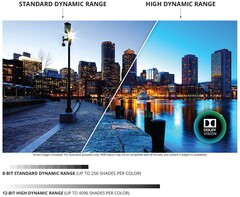VESA has revealed a new image-reproduction performance standard that may help ensure that a given screen is as bright, clear and accurate in terms of the content to be shown as possible. DisplayHDR version 1.1 is the first such panel of criteria that stipulates active dimming. This potential specification for the monitors of the future is associated with reductions in power consumption and significant improvements in black levels.
DisplayHDR v1.1 also calls for an enhanced dual-corner box test for black levels, a more accurate 10% color patch test for color gamut, as well as a new combined color luminance test. VESA has also devised a new Delta-ITP test, for luminance and D65 white balance reproduction. The new standards also mandate DisplayID accuracy, which ensures a given GPU gets access to a screen's DisplayID (or Extended Display Identification Data (EDID), the legacy counterpart of the same).
This enables the card in question to get the best performance out of its connected panel as it will always be able to push the appropriate signal. The addition of mandated on-screen menu DisplayHDR mode indication, and DisplayPort certification specification are other examples of performance optimization safeguards along these lines in this new HDR standard.
VESA has also made DisplayHDR 1400, a new standard for display performance, official. Its yardsticks results in a 40% increase in luminance, a 350% increase in contrast range and a 250% reduction in black levels compared to its predecessor (DisplayHDR 1000). DisplayHDR 1400 also calls for 95% of DCI-P3-D65, as opposed to 90% in DisplayHDR 1000.
This new standard also requires that a monitor be able to maintain a 900-nit brightness level in full-screen mode over 30 minutes. VESA has also announced that the first DisplayHDR 1400-compatible monitor has already been manufactured, and will shortly be released, by Asus. This high-quality display will be on show at IFA 2019, and is known as (surprise surprise) the ProArt Display PA32UCG.






















